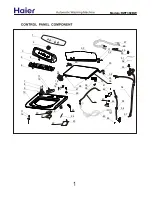
Check your dishwasher regularly
(approx. every 4 - 6 months). This
way faults and problems can be
avoided.
,
The outer surfaces of the
dishwasher are susceptible to
scratching.
Contact with unsuitable cleaning
agents can alter or discolour the
outer surfaces.
Cleaning the wash cabinet
The wash cabinet is largely
self-cleaning, provided that the correct
amount of detergent is always used.
If, however, there are limescale or
grease deposits in the cabinet, these
can be removed with a proprietary
dishwasher cleaner or conditioner.
Cleaning the door and the door
seal
^
Wipe the door seals regularly with a
damp cloth to remove food deposits.
^
When the dishwasher is being loaded,
food and drink residues may drip onto
the sides of the dishwasher door.
These surfaces are outside the wash
cabinet and are not accessed by
water from the spray arms. Any
soiling should be wiped off these
surfaces before the door is closed.
Cleaning the door front
,
Remove any soiling immediately.
If not, it might become impossible to
remove and could cause the outer
surface to alter or discolour.
^
Clean the front using a damp cloth or
with a sponge and a solution of hot
water and washing-up liquid. Then
dry with a soft cloth.
^
To avoid damaging the outer
surface, do not use:
– cleaning agents containing soda,
ammonia, acids or chlorides,
– cleaning agents containing
descaling agents,
– abrasive cleaning agents, e.g.
powder cleaners and cream cleaners,
– solvent-based cleaning agents,
– stainless steel cleaning agents,
– dishwasher cleaner,
– oven sprays,
– glass cleaning agents,
– hard, abrasive sponges and
brushes, e.g. pot scourers,
– sharp metal scrapers.
Cleaning and care
39
Summary of Contents for G 1XXX Series
Page 65: ...65 ...
Page 66: ...66 ...
Page 67: ...67 ...
Page 68: ...Alteration rights reserved G1142 1152 G2142 2152 1308 M Nr 07 066 491 00 ...
















































